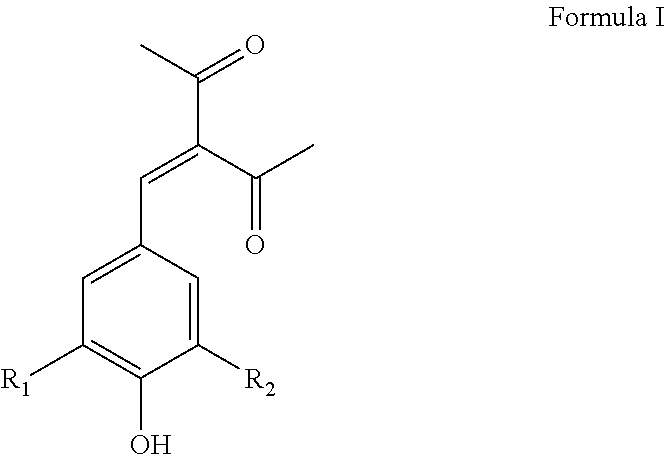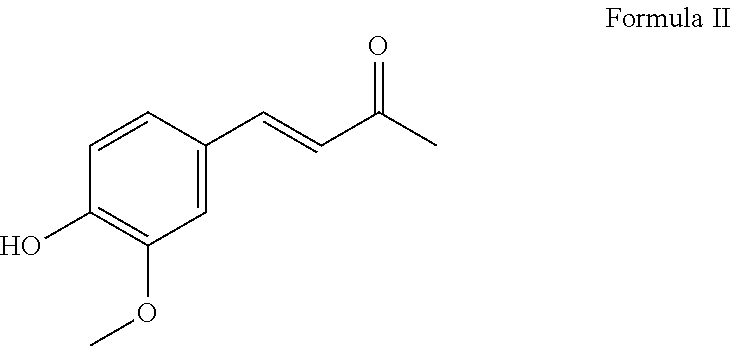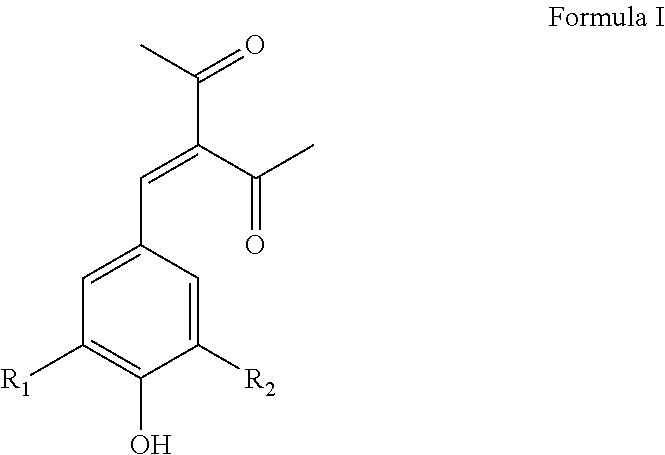Benzylidene substituted 2,4-pentanedione compounds and use thereof as stabilizers
a technology of benzylidene and pentanedione, which is applied in the preparation of carbonyl compounds, organic chemistry, hair cosmetics, etc., can solve the problems of inability to effectively quench free-radicals generated, significant, if not complete, loss of product integrity, etc., of the products into which they are formulated
- Summary
- Abstract
- Description
- Claims
- Application Information
AI Technical Summary
Benefits of technology
Problems solved by technology
Method used
Image
Examples
example 1
Synthesis of 3-(4-Hydroxy, 3-methoxybenzylidene)-2,4-pentanedione
[0078]3-(4-Hydroxy, 3-methoxybenzylidene)-2,4-pentanedione (Formula I wherein R1 is OCH3 and R2 is H, hereinafter “Synoxyl™ AS”) was prepared by the condensation of 3-methoxy-4-hydroxy benzaldehyde (vanillin) with acetyl acetone in the presence of piperidine and cyclohexane as the reaction medium at reflux temperature under continuous azeotropic water removal. The reaction takes about eight hours to complete after which period of time the reaction product is purified by crystallization with methanol. Typical yield is about 68% and comprises a yellow colored crystalline powder with a melting point of 135-137° C. and a λmax at 340 nm. The purity of the material as determined by GC was found to be 99.5%.
example 2
Antioxidant Profile of Synoxyl™ AS & Other Antioxidants
[0079]The antioxidant profile of the compound of Example 1, Synoxyl™ AS, was compared to two widely used commercial antioxidants, natural tocopherol and Oxynex® ST, a proprietary stabilizer based on Diethylhexyl Syringylidene Malonate (DESM), available form EMD Chemicals, Inc., of Gibbstown, N.J., USA. Several test methods were employed. The results as well as the specific test methods were as shown in Table 4.
TABLE 4Peroxyl*Hy-Peroxy-Super-SingletCompounds(ORAC)1droxyl*2nitrile*3oxide*4oxygen*5Synoxyl ™14,36347,18091,04213,283ASNatural1,6195001722,322TocopherolOxynex ® ST5500004,532*Units in Trolox equivalent / gm1Method used: B Ou et. al., J Agric Food Chem, 49(10): 4619-4626, 20012Method used: B Ou et. al., J Agric Food Chem, 50(10): 2772-2777, 20023Method used: L Zhang et al., Free Radic Bio Med, 43(suppl. 1): S17, 20074Method used: Dubost, N. J. et al., Food Chem, 105(2): 727-735, 20075Method used: Zhang, L. et al., J Agric F...
example 3
Photostabilization Study
[0081]A comparative photostabilization study was conducted comparing the photostabilization efficacy of Synoxy™ AS with Octocrylene and Oxynex® ST in the stabilization of avobenzone. Samples for evaluation were prepared as follows:
[0082]Solutions of the photosensitive material and photostabilizer in ethanol were prepared, typically at a 1:1 to 1:5 weight ratio. A base test solution of 3% Avobenzone+5% Octyl salicylate+10% Homoslate in ethanol (the “Test Solution”) was made. Four additional solutions were prepared by adding 2% Synoxyl™ AS, 4% Octocrylene, 2% Oxynex® ST, and 2% Dehydrozingerone, respectively, to four aliquots of the Test Solution.
[0083]Samples of each solution were prepared as ultra h n films between two quartz plates so as to obtain a minimum of 90% light transmission over the entire spectrum range of non absorbing chromophores. For example, ingredients which absorb only in the UV range were tested in formulation to obtain a minimum of 90% lig...
PUM
| Property | Measurement | Unit |
|---|---|---|
| Percent by mass | aaaaa | aaaaa |
| Percent by mass | aaaaa | aaaaa |
| Volume | aaaaa | aaaaa |
Abstract
Description
Claims
Application Information
 Login to View More
Login to View More - R&D
- Intellectual Property
- Life Sciences
- Materials
- Tech Scout
- Unparalleled Data Quality
- Higher Quality Content
- 60% Fewer Hallucinations
Browse by: Latest US Patents, China's latest patents, Technical Efficacy Thesaurus, Application Domain, Technology Topic, Popular Technical Reports.
© 2025 PatSnap. All rights reserved.Legal|Privacy policy|Modern Slavery Act Transparency Statement|Sitemap|About US| Contact US: help@patsnap.com



